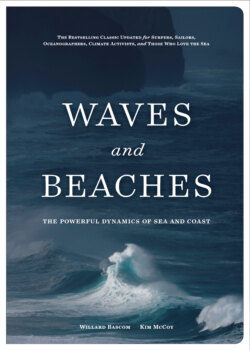Читать книгу Waves and Beaches - Kim McCoy - Страница 26
На сайте Литреса книга снята с продажи.
ORBITAL MOTION
ОглавлениеUntil now we have considered only the movement of the waveform along the surface of the water. Let us look inside the wave, at the motion of the individual water particles. What do they do as a wave passes? Since the water particles themselves cannot be seen, we must add a number of small markers to the water which will follow the water motions. The markers should be the same density as the water (neutrally buoyant), and easily visible.
FIGURE 10: Wave orbital motions decrease in size and flatten the deeper they are below the surface. In water deeper than half of the wave length, wave motions are so small they are negligible, little energy is lost, and the wave is considered a deep-water wave.
The circular lines in figure 10 outline the orbits of four particles at four different depths. All the orbits of particles are in the same direction at the same time—they are in phase.
The surface particle has a circular orbit exactly equal to the height of the wave. The next one down made a somewhat smaller circle. The third orbit is not only smaller but is slightly flattened, and the one at the bottom moves back and forth in a straight line. By combining a series of such measurements with theoretical work, it has been established that at a depth of one-ninth the wave length, the diameter of the orbit is approximately halved.
For simplicity, let us use a wave with a wave length of 9 units (feet or meters) which has a wave height of 1 unit. At the surface, our wave has an orbit diameter of one unit. Below the surface at a depth of one-ninth the wave length (1 unit depth), it is found to have a particle orbit of one-half unit. Yet deeper, at a depth of 2 units, the movement is reduced to one-fourth the surface orbit diameter. At 3 units depth, the movement is mostly horizontal and diminished to one-eighth the size of the surface value. (All depths are relative to the still-water level, the water level in the absence of waves.)
After a series of a dozen or so waves have passed, the near-surface particles are seen to be describing circles that are not precisely in line with the first ones. So we trace out the new path and find that the new orbit is a little farther from the wave generator.
